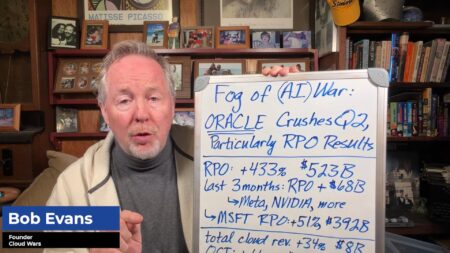In episode 34 of the Growth Swarm podcast, John Siefert, Bob Evans, Tony Uphoff, and Scott Vaughan define how to lead in uncertain and uneven times. In particular, they focus on the need to avoid knee-jerk staff reductions and wholesale cost-cutting and instead focus on strategic investments that drive the bottom line. People are among the most important resources for organizations.
Highlights
00:35 — John lays out the topic of today’s episode: How to lead through the uncertain times like those we’re currently experiencing. As executives, business owners, practitioners, and more, how do we manage through uneven times?
01:19 — For one of the first times in his professional career, John says the world is sitting in a position where there is geopolitical friction happening in what customers want, what they demand, what they’re looking for, and how they can be dazzled. Additionally, there is friction in customers’ willingness to invest and spend, due to fears that “money doesn’t go as far as it used to.” For practitioners, analysts, and business leaders, this leaves a lot of question marks. The world must be adaptive and consider different solutions in different ways in order to tackle the current situation.
02:41 — John asks Bob to give his point of view on how business leaders should consider how they are managing through uncertain and uneven times. Bob says much of this comes down to the notion of leadership and culture inside an organization. This is a wildly different time: leadership has to “be able to set the culture mapped by what’s going on in the outside world, and how can you set this organization up so it’s 100% customer-focused, customer-oriented,” explains Bob. Phrases like “do more with less” are “knee-jerk” reactions that are dangerous in these times, as they take the focus off of real issues that businesses face.
04:56 — Sometimes business leaders don’t have a choice but to decide “how to do more with less” but it should reflect a greater focus on reprioritization. Tony has spoken a lot about resource allocation and prioritization, and John asks him for his thoughts.
06:45 — Tony notes that this is such a timely topic because there aren’t simple answers: Leadership is hard. He defines leadership as “not having all the answers, but still having to get people and the business through the process.” Business leaders in today’s world must “lead with a capital L” and truly understand the challenges, which may require new thinking about resource management. Tony encourages other leaders not to let “misinformation spook you,” given the extraordinary amount of noise in the media about technology replacing jobs and tech layoffs.
09:31 — John emphasizes that industry-wide tech layoffs are a reality and many lives have been changed — this is not something that can be glossed over. Rather than sending a mass email out notifying employees of their job loss, John says this needs to be a calculated, emotionally-intelligent discussion. These layoffs are driven by pressure on publicly traded companies to deliver shareholder value.
11:27 — Scott says the unevenness of the current market, coupled with fear-mongering headlines, is creating a challenging situation for businesses. Many leaders are considering making cuts to their departments or teams to adapt to the new environment, but instead of simply cutting back, they need to focus on making strategic investments in areas that can help drive the business forward. This means putting more resources into areas that can generate cash or lead them into new markets. This approach may involve taking some tough risks, but it is better than making blanket cuts that do not add any value.
13:04 — The second key factor to consider, Scott continues, is the talent gap. There are still millions of job openings in the U.S. alone, and finding the right people to fill those positions is crucial. As a leader, you need to focus on attracting and retaining high-performing and high-potential employees. This means putting them in positions where they can contribute the most to the business’s success.
13:44 — Thirdly, instead of seeing competitors as enemies, leaders can look for creative ways to collaborate and reduce costs. By working with our competitors and customers, we can find ways to leverage each other’s strengths and make the most of existing resources. Ultimately, by focusing on strategic investments, talent retention, and collaboration, we can adapt to the new environment and position our businesses for success.
15:13 — John says that it’s important to recognize that some cutting may be necessary to save jobs and customers, but applying it to everything in the company is not the solution. Determining which areas to cut and which to prioritize will enable the company to navigate through uneven times and emerge stronger. John adds that Scott’s idea of embracing and supporting high performers within the organization is also crucial, so that they are in the right positions to help drive the company forward.
16:33 — Bob says that leaders don’t set the culture, they create the tone and environment that allows the right culture to thrive. Companies with a strong culture won’t resort to across-the-board pay cuts or layoffs when tough times hit. They won’t make high-performing employees feel undervalued or fearful for their jobs. Instead, they’ll focus on growth, innovation, and excellence, then work together to weather the storm.
17:25 — Instead of crumbling when faced with adversity, leaders must step back, assess the situation calmly and intelligently, and work together with their team to move forward. This unified approach ensures that everyone is on the same page and does the right thing, and no one feels like they’re just a number or disposable.
18:17 — In summation, Tony says that what sets this period apart is the speed at which technology is advancing and the rapid pace of change. It is during these times that we not only need to allocate resources and make difficult decisions, but also need to “double down” on our North Star, or the core competency of our business. It may be that the core competency of a business is eroding, and leaders may need to make difficult transitions to adapt to the changing times. These are transformative times, and legacy businesses are feeling the pressure. However, even in times of change, we must carefully consider our resources and avoid spreading them too thin. Tony emphasizes the importance of talent. People are the ultimate resource, and most companies have remarkable talent. It is crucial to ensure that your employees understand the company’s mission, where it is headed, and how they can contribute to its success.
20:09 — On this point, John adds that organizations have to ensure that their employees’ skill sets are right-sized to adapt to the changing needs of the company. Even top performers may need upskilling if their area of expertise is no longer in high demand.
21:51 — John backs up an earlier point from Scott about the importance of “linking arms” with competitors and partners, because partner ecosystems are defining where the world is going. Not only do today’s organizations need to figure out how to prioritize and tighten their belts, but they’re also going to need more help. John concludes by asking everyone to link arms a little bit more, complain a little bit less, and focus on the things that we can impact more. “That’s how we start to create a horizon that’s a little bit brighter,” he says.
Want more tech insights for the top execs? Visit the Leadership channel:









